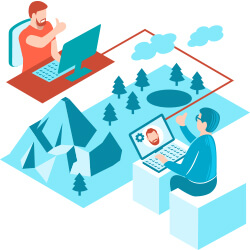Part 4 of 4
Technical support: Whom should I call if something goes wrong?
Unlike on-site support, where it is usually quicker and easier to solve a problem with direct access to equipment, remote support tends to involve certain difficulties and risks that employees need to be aware of.
Firstly, employees need to have the contact details of the person to address when they need to report a problem or ask for assistance. It is important to always have this information stored on various devices, so that if one device becomes unavailable, the contact information is still accessible.
The same applies to the contact details for reporting a security incident, such as a theft or loss of equipment. In this case, it is of utmost importance to notify your employer as soon as possible. This will allow the IT administrator enough time to respond rapidly and execute the corresponding security protocols that will prevent information from being compromised.
A lot of companies use remote desktop protocol (RDP) to give IT technicians remote access to corporate devices. Many RDP tools are available to the public for free, meaning they can be used by anyone. It is important to be aware that there are various RDP scams where hackers aim to convince users there is a problem with their computer that requires technical support and RDP access, when this is not really the case.
So, whatever your situation, always contact your employer’s technical support and be sure it is really them accessing your device. Do not give remote access to any unknown or suspicious people.
It is also advisable to pay attention to the actions taken by the support person on your device, whether you have technical knowledge or not, because it is your responsibility to ensure they do not access confidential information in the process. You can pull the plug on your home router – a quick remedy to disconnect RDP – if necessary.
Best practices
During current times of increased remote work, the security of business data resides to an even greater extent in the hands of employees. In order to best mitigate the risks, businesses should adhere to the following best practices:
- Encrypt information stored on work devices.
- Install endpoint security software on devices and keep it up-to-date.
- Keep devices (also) up-to-date, including the operating system and applications.
- Secure and properly configure home networks.
- When connecting to a public network or Wi-Fi hotspot, always use a VPN and avoid accessing sensitive information.
- Periodically back up your data.
- Protect your devices with passwords and be wary of leaving them unattended while logged in.
- Enable anti-theft protection on your devices.
- Use two-factor authentication to protect your critical accounts.
- Always have in hand the contact information for your technical support and report any security incidents as soon as possible.
- Watch out for the latest scams and threats by following WeLiveSecurity news.
Conclusion
In this guide we have looked at the risks entailed by remote work and how businesses can significantly improve employees’ behavior to mitigate those risks and improve the security of communication over remote networks.
Keeping in mind the advance of 5G, IoT devices and other technologies – compounded with the accelerating force of COVID-19 – remote access to information by employees working from home is undoubtedly a foremost business concern.
The employee at home has become a fundamental piece in managing the security of your business data and processes. To face the new challenges, organizations must have clear policies for information management and adequate tools that allow employees to carry out their activities safely.
Changing the manner of working within a company needs to involve all employees and can take time. But with the right training, employees can quickly understand the risks of remote work and know how to avoid or counteract them. We are confident that this guide has furthered that goal.
Looking for a comprehensive set of remote workforce resources for your IT admins and employees?
The complete Remote Worker’s Guide series:
Part 1: Risks, threats and corporate policy
Part 2: Remote working tools for employees
Part 3: Network connectivity
Part 4: Technical support and best practice
